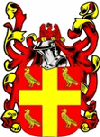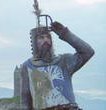Zeke
Posts: 42
Joined: 2/1/2005
Status: offline

|
I have to say el cid's above mentioned understanding of the China theatre is largely flawed, to say the least. Wang Ching-wei, the number 2 leader of the KMT, never was able to get any significant part of KMT army followed with him to the Japan side. And to say afterward a gigantic portion of the ROC went over to Japan is a big overstatement. Actually there was some widespread conspiracy theory that Chiang Kai-Shek intentionally devised the plan and mislead Wang Ching-wei into the exile to the Japan side. As a result Chiang Kai-Shek's situation inside KMT was significantly secured and strengthened, since his long time competitor, Wang Ching-wei, now took the wrong side, and it turned out that even those former supporters of Wang Ching-wei inside KMT now had to join Chiang Kai-Shek's coalition to denounce Wang Ching-wei's betrayal and fight against him under the unchallenged leadership of Chiang Kai-Shek. That happened between late 1938 and early 1940.
Therefore, realized that his Nanking "Puppet" government had a military wing of virtually zero strength, Wang Ching-wei had to seek help from Japan. He made a plan to have an army of 10 divisions armed and trained. But that plan received little success till the end of the war on Aug 1945.
It was true that ROC army rarely took large scale offensive action after Nov 1937, the fall of Shanghai (not Nanking), where ROC army's 3(not 10) most well-equiped and well-trained divisions were largely depleted. The reason was simply lack of supply to support large scale offensive action, as it was showed in WITP. So after Oct 1938, the fall of Wuhan, throughout most part of China theatre, the war was carried out in such a typical way, that Japanese army launched a large scale attack, ROC army defended and inflicted heavy loss on enemy, then Japanese army had to give up and retreated to its starting line, and ROC army had to stop there due to supply shortage. So the positions of frontline remained relatively unchanged until 1944, but the battles were quite intensive.
ROC army was not capable in offensive action due to supply problem, but they were formidable in defence.
I am listing the simplified OOB of the Third Battle of Changsha, a Japanese attempt to capture Changsha from Wuhan, as an example. Starting from Dec 24, 1941, It was designed to keep ROC army from reinforcing Hongkong. But the earlier than expected capture of Hongkong made this one the main battleground.
Japan:
6th Division
3rd Division
40th Division
Mixed 14th Bde
Mixed 9th Bde
34th Division
ROC:
26A
79A
78A
72A
20A
58A
37A
99A
10A
73A
74A
4A
After bloody battles, Japanese army approached and started attacking Changsha from Jan 1, 1942. The attack failed with heavy loss and Japanese started retreating since Jan 4, 1942, and it took them 12 days to finish the 50 kilometers trip back to the starting line.
Talking about China Red Army, which means 18th Group Army (18GA, at first named as 8th Route Army) and "New 4th Army"(N4A), they did actively seek battle a lot with Japanese army, but most battles were in scale of regiment or even lower, in a semi-guerilla style. 18GA had only 3 divisions, 115D, 120D and 129D. N4A had 7 divisions in name, but the overall strength of N4A was roughly equal to one division of 18GA.
"Puppet" Mongolian Army, consisted of around 9 divisions, basically was disabled after crushed by the 35th Army of ROC led by its commander General Fu Tso-yi in Nov 1936. It was extremely low in morale, and very poor in equipment. "Puppet" Manchurian Army was nothing better, if not much worse. and it never stepped outside of Manchuria. Both were far from capable even used as police force.
There were just no instance of ROC Central Army switching side to Japan. And the only instance of significant number of ROC Army switching side to Japan, happened in May 1943. The commander of "New 5th Army"(N5A), General Sun Tienying, surrendered after defeated and captured by Japanese Army north of Henan. A large part of N5A surrended with him. N5A was an army of minor warlord, in other words, a ROC provincial army, in contrast to ROC central army, so it was smaller in size, consisted of only 2 small divisions(T3D and T4D). It kept the name of N5A after join Wang Ching-wei's puppet army.
After all, in early 1944, Wang Ching-wei's puppet army grew to around 280,000 people, organized in 7 Group Army. But these puppet army's morale was so low that their commanders explicitly refused being sent to frontline to fight against Chiang Kai-Shek's army, and throughout the war there were not any puppet army used in frontline. They were limited useful as police force against China Red Army's semi-guerilla war. but the usefulness were largely balanced by the fact that China Red Army acquired most of their weapons from attacking and destroying these puppet army.
In short, China Theatre was a theatre large and complicated but lack in thorough research and understanding. How to accurately simulate it is still an issue to be discussed.
(to be continued)
< Message edited by Zeke -- 6/18/2007 6:44:20 PM >
|
 Printable Version
Printable Version







 . But I must say the tasks are arduous.
. But I must say the tasks are arduous.


 New Messages
New Messages No New Messages
No New Messages Hot Topic w/ New Messages
Hot Topic w/ New Messages Hot Topic w/o New Messages
Hot Topic w/o New Messages Locked w/ New Messages
Locked w/ New Messages Locked w/o New Messages
Locked w/o New Messages Post New Thread
Post New Thread